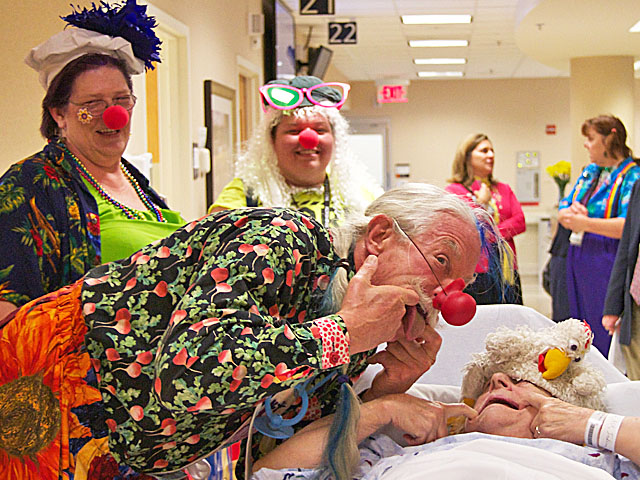No one knew how to treat the patient better than Patch Adams. Based on his life, the movie Patch Adams came out in 1998 before I started medical school. Hunter Doherty “Patch” Adams knew what it meant to be a doctor. He kept the doctor-patient relationship alive even in the thick of devastating illness. When he founded the Gesundheit! Institute in 1971, he had it right, and I hope America can get it right too. Not that doctors have to open an institute like Patch did, but they should always remember what medicine is really about. People.
Making a Difference One Patient at a Time
You treat a disease: you win, you lose. You treat a person, I guarantee you win – no matter the outcome.
Patch Adams
That’s why healthcare reform sounds like a great idea. Get more people the access they need. Improve the quality of healthcare provided. Get doctors on electronic health records (EHRs) so they can more easily coordinate care between specialists. The patient gets more attention and better care across the board.
Where Healthcare Reform Falls Short
The problem is not the idea of healthcare reform but the how of it. Regulations and red tape are changing the very heart of medicine, inadvertently pushing doctors AWAY rather than TOWARD patient care.
For many doctors these days, medicine feels more like a job than the “art of medicine” they signed up for. Doctors and other healthcare providers did not come into this to sit at a desk all day entering data. They did it to help people. The amount of hoop jumping for administrative tasks leaves little time for what really matters — the patients.
Electronic Health Records:
Not all doctors are computer savvy, and I have met more than a few who retired early rather than deal with the stress of transitioning from paper to electronic health records (EHRs). For those who do start on an EHR, the costs are high and the learning curves steep. Not only do medical offices often need to purchase new hardware, but they need to pay for annual licenses to the EHR program for each user as well as tech support.
The Centers for Medicare and Medicaid Services requires that doctors meet criteria for meaningful use with their EHRs. While it is important to optimize the use of an EHR, every healthcare provider must battle the nuances of the specific EHR they chose. If meaningful use criteria are not met by a certain date, those doctors will be paid less. This forces doctors to change how they practice medicine. Many doctors find their noses buried in screens to get their work done. For some providers, more time is spent documenting their charts than in face-to-face care.
Pay for Performance:
Now add to this the issue of pay-for-performance. In some cases, doctors are paid more or less based on how well they can control a patient’s numbers — blood pressures, sugar levels, etc. How fair is it to judge a provider when those magic numbers may not be attainable, by genetics or otherwise? Or when the patient does not take their medications as prescribed? The doctor may be working as hard as any other but is penalized despite their best efforts.
The sustainable growth rate formula is another way that doctors have been demoralized. The formula aims to cut payments to doctors by significant rates every year, and though stop-gap measures are put in place, Congress fails to repeal it. The threat lingers on. With decreased reimbursements, many doctors are forced to see more patients to keep their clinic doors open.
Doctors, Remember to Treat Your Patients
I overhear the public talk that doctors get paid too much, not acknowledging their high educational debts or the amount of time spent in training. It makes me wonder how workers in other fields would feel if pay cuts were threatened every year? In most other professions, promotions come into play, not demotions. Work harder to get paid less.
I myself had become disillusioned by the new medical regulations. I took to medical necessity compliance and utilization reviews to learn more about the non-clinical side of medicine. Sure enough, the information I gleaned allowed me to write two books, and I will always be grateful for that. But I will always be a doctor at heart. People are what matter most.
See the Whole Patient, Not the Problem
Doctors, you have to bring it back to the patient. Patients are the reason we came into medicine, and if it isn’t, maybe this isn’t the profession for you. You have to look up from your computer screen and see the person in front of you. Listen to them.
- When he asks you about his prognosis, answer him truthfully and honestly, not with fears of litigation.
- When she calls you with questions, she is genuinely concerned. Do not make her wait days for answers.
- Make them well, if not by curing them — because too often you cannot — but by treating them with dignity and respect.
- Be charitable with your time when you can.
It is not always an easy feat to give of yourself when you have so many other tasks to complete or when the patient does not treat you with the same kindness. But when you lose sight of why we are doctors, you lose sight of everything. Make it worth your while and their while. Maybe that means changing how many patients you see, changing your work hours, or making changes to your practice workflow. The how is for you to decide. What matters is that you find your heart in medicine again. Treat your patients, not the disease.

